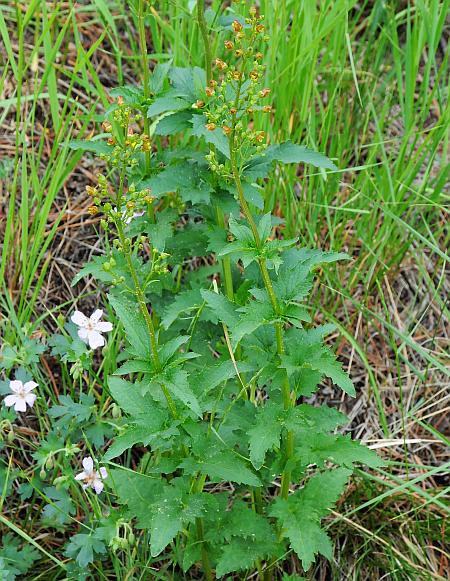Scrophularia lanceolata Pursh
American Figwort

Native
CC = 10
CW = 3
MOC = 2
© SRTurner
Scrophularia lanceolata PurshAmerican Figwort | |
 |
Native CC = 10 CW = 3 MOC = 2 |
© SRTurner |
|
Family - Scrophulariaceae Habit - Fibrous-rooted perennial forb. Stems - Ascending to erect, to 1.5 m, 1 to several from the base, unbranched or few-branched, with 4 blunt angles and flat to slightly concave sides, moderately pubescent with minute, glandular hairs, at least toward the tip.
Leaves - Opposite, simple, petiolate. Petioles of the larger leaves 1-4 cm long, winged toward the tip, grooved on the upper side, the margins of the groove with pale, slightly thickened ridges. Leaf blades 4-20 cm long, lanceolate to narrowly ovate, variously tapered or angled to rounded, truncate, or shallowly cordate at the base, sharply, irregularly, often coarsely, and sometimes doubly toothed along the margins, the upper surface glabrous, the undersurface glabrous or sparsely and minutely glandular-hairy along the main veins.
Inflorescences - Terminal, elongate, roughly cylindrical panicles mostly 4-8 cm wide, the main branches ascending to strongly ascending, usually with numerous flower, the lower branches bracteate, the flowers mostly long-stalked, the stalk with a pair of minute, linear bractlets at the base, the axes, flower stalks, and bractlets usually with dark, stalked glands.
Flowers - Calyces actinomorphic, 2-4 mm long, 5-lobed to about the midpoint, the lobes ovate, with irregular margins. Corollas bilabiate, 7-12 mm long, yellowish green, usually with pale reddish-brown to brown mottling, sometimes appearing pale reddish brown except for the inner surface of the lowermost lobe, the tube urn-shaped to broadly urn-shaped, the upper lip more or less straight, about as long as to slightly longer than the lower lip, notched at the tip, the lower lip strongly 3-lobed, the lateral lobes broadly ovate to nearly circular, more or less straight, the central lobe, triangular-ovate, strongly reflexed. Stamens 4, not exserted, the free portions of the filaments short, the anthers appearing 1-celled, yellow. Staminode 1, well differentiated, consisting of a filament with a yellowish-green, flattened, fan-shaped, tip oriented under the upper lip. Ovary broadly ovoid to nearly globose, 2-locular. Style usually longer than the ovary, usually slightly exserted, the stigma 1, unlobed, capitate.
Fruits - Capsules 6-10 mm long, the body ovoid, tapered at the tip, the surface dull at maturity. Flowering - May - June. Habitat - Forest openings, roadsides, disturbed areas. Origin - Native to the U.S. Lookalikes - S. marilandica. Other info. - This species is rare in Missouri at most, recorded from only three counties, most recently in 1940. It is more common in northern regions of the U.S., and also in states to our west, where it is the dominant species of Scrophularia to be found. The plant is easily recognized as a Scrophularia by its square stems with opposite leaves and its small, urn-shaped flowers having a reddish blush. The most obvious difference between this species and Missouri's far more common S. marilandica is the leaf shape. S. lanceolata has very coarsely and somewhat irregularly toothed leaf margins, whereas S. marilandica leaves are more finely and regularly toothed. Photographs taken in Estes Park, Larimer County, CO, 6-19-2018 (SRTurner). |